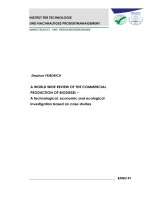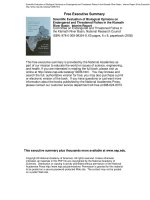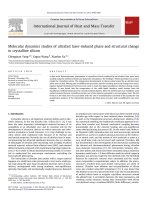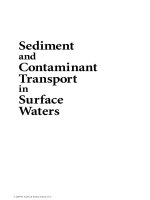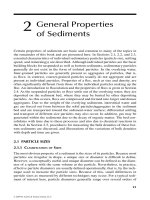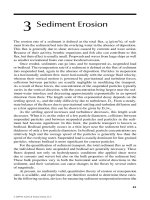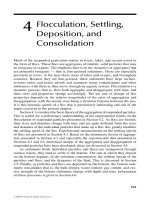Production of biodiesel from vegetable oils and animal fats in waste water
Bạn đang xem bản rút gọn của tài liệu. Xem và tải ngay bản đầy đủ của tài liệu tại đây (526.73 KB, 9 trang )
TAẽP CH PHAT TRIEN KH&CN, TAP 16, SO M1- 2013
Production of biodiesel from vegetable oils
and animal fats in waste water
Duong Thi Thanh Thuy
Pham Trung Kien
Ho Chi Minh City University of Agriculture and Forestry
Nguyen Van Phuoc
Institute for Environment and Resources, VNU-HCM
Nguyen Thi Thanh Phuong
University of Technology, VNU-HCM
(Manuscript Received on January 21st, 2013, Manuscript Revised May 22nd, 2013)
ABSTRACT:
This study was performed to produce
6 g; ratio of 4:1, 5:1, 6:1, 7:1 MeOH : grease.
biodiesel from vegetable oils and animal fats
The reaction temperature was 600C. The
in waste water of Park Hyatt Saigon hotel.
optimal reaction conditions were found to be
The survey was performed to determine the
90 minutes, catalyst dosage of 4 g, ratio of
optimum reaction condition for converting
5:1 MeOH : grease. The efficient conversion
waste grease into biodiesel. The reaction
achieved 80% biodiesel and 20% crude
was conducted at 60, 90 and 120 minutes;
glycerin.
the catalyst dosage (NaOH) of 2, 3, 4, 5 and
Keywords: biodiesel, grease, catalyst, glycerin.
1. INTRODUCTION
Biodiesel has similar characteristics to diesel
fuel, but not made from mineral oil. It is made
from vegetable oils or animal fats, be used as
diesel fuel.
The use of biodiesel has several advantages
over
normal
diesel,
including:
easily
biodegradable and renewable, so it is an
environmentally friendly fuel [1] with lower
emissions of CO, CO2, soot particles and
hydrocarbon [2]; relatively high flash point
(1500C) so safety in transport and storage [3];
Biodiesel is better than diesel because it has low
in sulfur content, aromatics and a high cetane
number [4].
There are three basic methods to biodiesel
production: micro-emulsion, pyrolysis (thermal
cracking) and transesterification. In particular,
the best evaluation is for transesterification
because the characteristics of this product are
suitable for diesel engines [5].
The transesterification process is the reaction
of a triglyceride (fat/oil) with an alcohol to form
esters fatty acids and glycerol [5]. This reaction
can be carried out with catalyst or not catalyst.
When dont use catalyst, the reaction can be
carried out by supercritical method [6, 7], or Biox
Co-solvent Process. Alkaline [8] and acid [9, 10,
11] or enzyme [5] are the catalysts that can be
used in transesterification. However, alkaline is
Trang 5
SCIENCE & TECHNOLOGY DEVELOPMENT, Vol 16, No.M1- 2013
more effective than acid in a short time, low
reaction temperature. Alkaline can be used with
little dosage and it rarely make dark products.
Enzyme is too expensive to use for
industrialization [5].
There are three kinds of alkaline catalysts:
alkaline metals, alkaline oxide or hydroxide. The
reaction mechanism for alkaline-catalyzed
transesterification was formulated in three steps.
The first step is the reaction of the base with the
alcohol, producing an alkoxide and the
protonated catalyst. The nucleophilic attack of
the alkoxide at the carbonyl group of the
triglyceride generates a tetrahedral intermediate
from which the alkyl ester and the corresponding
anion of the diglyceride are formed (Step 2). The
latter deprotonates the catalyst, thus regenerating
the active species, which is now able to react
with a second molecule of the alcohol, starting
another catalytic cycle. Diglycerides and
monoglycerides are converted by the same
mechanism to a mixture of alkyl esters and
glycerol.
In
general,
alkaline-catalyzed
transesterification processes are carried out at low
temperatures and pressures (333–338oK and 1.4 –
4.2 bar) with low catalyst concentrations (0.5–2
wt.%) [12]. Alkaline metal alkoxides are the
most active catalysts because they give very high
yield (> 98%) in short reaction time (30 min)
even if they are applied at low molar
concentrations (0.5 mol%). However, they
require the absence of water so they are
inappropriate in industrial processes [13].
Alkaline metal hydroxides (KOH and NaOH) are
cheaper than metal alkoxides, but less active.
Nevertheless, they can hi����������������������������������������������������������������������������������������������������������������������������������������������������������������������������������������������������������������������������������������������������������������������������������������������������������������������������������������������������������������������������������������������������������������������������������������������������������������������������������������������������������������������������������������������������������������������������������������������������������������������������������������������������������������������������������������������������������������������������������������������������������������������������������������������������������������������������������������������������������������������������������������������������������������������������������������������������������������������������������������������������������������������������������������������������������������������������������������������������������������������������������������������������������������������������������������������������������������������������������������������������������������������������������������������������������������������������������������������������������������������������������������������������������������������������������������������������������������������������������������������������������������������������������������������������������������������������������������������������������������������������������������������������������������������������������������������������������������������������������������������������������������������������������������������������������������������������������������������������������������������������������������������������������������������������������������������������������������������������������������������������������������������������������������������������������������������������������������������������������������������������������������������������������������������������������������������������������������������������������������������������������������������������������������������������������������������������������������������������������������������������������������������������������������������������������������������������������������������������������������������������������������������������������������������������������������������������������������������������������������������������������������������������������������������������������������������������������������������������������������������������������������������������������������������������������������������������������������������������������������������������������������������������������������������������������������������������������������������������������������������������������������������������������������������������������������������������������������������������������������������������������������������������������������������������������������������������������������������������������������������������������������������������������������������������������������������������������������������������������������������������������������������������������������������������������������������������������������������������������������������������������������������������������������������������������������������������������������������������������������������������������������������������������������������������������������������������������������������������������������������������������������������������������������������������������������������������������������������������������������������������������������������������������������������������������������������������������������������������������������������������������������������������������������������������������������������������������������������������������������������������������������������������������������������������������������������������������������������������������������������������������������talyst dosage from 2 to 4
grams, the reaction efficiency increased and
achieved the highest value at the dose of 4 grams
for all experiments. In case of increasing the
catalyst dosage above 4 grams, the efficiency
reduced because soap formation occurred and
tended to increase with higher quantity of
catalyst and also backward reaction was favored
at thus condition. In addition, according to F. Ma,
L. D. Clements, M. A. Hann [22], if more free
fatty acids and water exist in the reactants, more
NaOH is needed to neutralize the free fatty acids
and react with triglycerides to produce soap [22].
Increasing ratio of MeOH: grease had a
positive effect on the reaction yield as it helped
to drive the reaction equilibrium forward. The
efficiency increased with an increase ratio of
MeOH : grease from 4:1 to 5:1 but decreased
when ratio increased from 5:1 to 7:1 in Fig 2, 3
and 4. Transesterification is an equilibrium
reaction in which a large excess of MeOH is
required to drive the reaction to the right. The
high molar ratio of MeOH : grease interfered
with the separation of glycerin because there was
an increase in solubility. When glycerin remained
in solution, it helped drive the equilibrium to
back to the left, lowering the efficiency of esters.
After the reaction, residual MeOH created the
hydrogen bond with ME and glycerin. When the
volume of the hydrogen bond was too large, it
caused the phenomenon of emulsion in
product. This phenomenon was difficult for
separation and cleaning of product, so the
efficiency of biodiesel decreased. Fig 2, 3 and 4
showed the optimum ratio of MeOH : grease was
5:1. This result was different compared to report
of Dr. Lima Rose Miranda (the optimum ratio of
6:1 MeOH:grease [25]).
Fig 2. The efficiency of biodiesel in 60 minutes
Fig 3. The efficiency of biodiesel in 90 minutes
Trang 8
TAẽP CH PHAT TRIEN KH&CN, TAP 16, SO M1- 2013
Fig 4. The efficiency of biodiesel in 120 minutes
Fig 5. The efficiency in different reaction time
3.3. Survey of optimum reaction time
Effect of reaction time on the efficiency of
but
favored
the
reverse
reaction of
biodiesel is showed Fig 5. From 60 to 90
transesterication, causing a reduction in the
minutes, the efficiency of biodiesel increased and
product yield. Similar result was observed by
achieved the highest value of 90 minutes. When
Leung and Guo [26]. It is clear that the optimum
the reaction time was more than 90 minutes, the
reaction time was 90 minutes with the efficiency
efficiency decreased because long reaction time
of 81%. Similar reaction time has been reported
0
at high temperature (60 C) nearby the boiling
in Viet Nam (Le Thi Thanh Huong et al) [27]
point of methanol, so methanol could be easily
3.4. Characteristics of biodiesel
undergone some loss [27]. In addition, the side
Biodiesel product was analyzed at quality
effects (saponification or esterification) occurred
assurance and testing center 3 (quatest 3).
strongly. The transesterification reaction is
The analysis results show in Table 3. Some
reversible. With residual MeOH, the reaction
parameters met Vietnam Standards TCVN
occurred according to the straight direction of
7717:2007 such as acid number, Kinematic
motion in a certain period of time and the excess
viscosity at 400C and density at 1150C/150C.
reaction time could not promote the conversion
Table 3. Fuel properties of biodiesel
Fuel properties
Acid number (TAN)
The flash point with closed cup
0
Kinematic viscosity at 40 C
Unit
Analysis methods
Result
TCVN 77172007
mgKOH/g
ASTM D 664 07
0,3
0,5
C
ASTM D 93 08
18
130 (min)
2
ASTM D445 06
6,031
1,9 -6,0
0,13
0,05
0
mm /s
Carbon residue content by mass
%
Freezing temperatures
0
Water content
0
ASTM D4530 07
Micro methods
C
ASTM D 97 - 08
+9
-
mg/kg
ASTM D 6304 - 07
900
200
ASTM D 4052 96 (2002)
0,8838
-
ASTM D 4052 96 (2002)
883,0
860-900
0
Density at 15 C/15 C
0
Density at 15 C
3
kg/m
Trang 9
TAẽP CH PHAT TRIEN KH&CN, TAP 16, SO M1- 2013
4. CONCLUSION
Biodiesel production from waste grease by
transesterification with catalyst NaOH is cheap,
safe and high in yield. Results of the study
clearly demonstrate that the use of waste grease
is very suitable as low cost feed stocks for
biodiesel production. The optimum reaction
conditions were determined the reaction time 90
minutes, catalyst dosage of 4 g, ratio of 5:1
MeOH : grease; the efficiency for biodiesel was
80 % and 20% for crude glycerin. Biodiesel is a
new alternative transportation fuel, whereby
reduce the amount of grease discharged to the
environment and also to reduce the imported fuel
oil, and bring economic benefit. However, more
research is needed to improve the quality of
biodiesel.
Acknowledgements: This study was supported by
Institute for Environment and Resource Vietnam National
University Ho Chi Minh City.
Nghiờn cu sn xut Biodesel t du m
ng thc vt
Dng Th Thanh Thy
Phm Trung Kiờn
Trng i hc Nụng Lõm Tp.HCM
Nguyn Vn Phc
Vin Mụi trng v Ti nguyờn, HQG-HCM
Nguyn Th Thanh Phng
Trng i hc Bỏch khoa, HQG-HCM
TểM TT:
Nghiờn cu sn xut biodesel t du m
ng thc vt c thc hiờn trờn nc thi
ca khỏch sn Park Hyatt Saigon. Ni dung
nghiờn cu nhm tim ra iu kiờn ti u
cho phn ng chuyn húa du m thi thnh
biodiesel. Trong ú, cỏc yờu t cn kho sỏt
l: Thi gian phn ng 60, 90 v 120 phỳt,
hm lng cht xỳc tỏc kim (NaOH) l 2, 3,
4, 5, 6 gam, t lờ mol MeOH:du m l 4:1,
5:1, 6:1, 7:1. Nhiờt phn ng c c
inh 60oC. Kờt qu nghiờn cu trong iu
kiờn PTN ó xỏc inh thi gian ti u cho
phn ng l 90 phỳt vi hm lng xỳc tỏc
4g v t lờ mol MeOH:du m l 5:1. Phn
du m ng thc c thu hi t nc thi
cú th chuyn húa thnh biodiesel vi hiờu
xut 80%, v 20% glycerin thụ.
T khoa: biodiesel, du m, glycerin, cht xỳc tỏc.
Trang 9
SCIENCE & TECHNOLOGY DEVELOPMENT, Vol 16, No.M1- 2013
REFFERENCES
[1].
[2].
[3].
[4].
[5].
Demirbas A. Biodegradability of biodiesel
and petrodiesel fuels. Energy Sour, Part A:
Recov Utiliza Environ Effects 2009;
31:169–74.
[10]. Li Y, Zhang XD, Sun L, Zhang J, Xu HP.
Yee KF, Tan KT, Abdullah AZ, Lee KT.
Life cycle assessment of palm biodiesel:
revealing
facts
and
benefits
for
sustainability. Appl Energy 2009; 86:189–
96.
[11]. Miao X, Li R, Yao H. Effective acid-
S. Lee, D. Posarac, N. Ellis. An
experimental investigation of biodiesel
synthesis from waste canola oil using
supercritical methanol. Fuel 91 2012: 229–
237
Martini N, Schell S. Plant oil as fuels:
present state of future developments. In:
Proceedings of the synopsis. Portdam,
Germany, Berlin: Springer; 1998. p. 6.
Mustafa Balat *, Havva Balat. Progress in
biodiesel processing. Applied Energy 2010;
87: 1815–1835
Fatty acid methyl ester synthesis catalyzed
by solid superacid catalyst /ZrO2–TiO2/La3+.
Appl Energy 2010;87:156–9.
catalyzed transesterification for biodiesel
production. Energy Convers Manage
2009;50:2680–4.
[12]. Lotero
E, Goodwin JG, Bruce DA,
Suwannakarn K, Liu Y, Lopez DE. The
catalysis of biodiesel synthesis. Catalysis
2006;19:41–83.
[13]. Schuchardt U, Sercheli R, Vargas RM.
Transesterification of vegetable oils: a
review. J Braz Chem Soc 1998;9:199–210
[14]. Canakcı M, Van Gerpen J. Biodiesel
production from oils and fats with high free
fatty acids. Trans ASAE 2001;44:1429–36.
[15]. Zagonel GF, Peralta-Zamora PG, Ramos
LP. Production of ethyl esters from crude
soybean oil: optimization of reaction yields
using a 23 experimental design and
development of a new analytical strategy for
reaction control. Preprints Symp: Am Chem
Soc Div Fuel Chem 2002;47:363–4.
[6].
Prafulla Patil, Shuguang Deng, J. Isaac
Rhodes, Peter J. Lammers. Conversion of
waste cooking oil to biodiesel using ferric
sulfate and supercritical methanol processes.
Fuel 89, 2010:360–364
[16]. Dias JM, Alvim-Ferraz MCM, Almeida
[7].
S. Lee, D. Posarac, N. Ellis. An
experimental investigation of biodiesel
synthesis from waste canola oil using
supercritical methanol. Fuel 91, 2012: 229–
237
MF. Comparison of the performance of
different homogeneous alkali catalysts
during transesterification of waste and
virgin oils and evaluation of biodiesel
quality. Fuel 2008;87: 3572–8.
[8].
Freedman B, Pryde EH, Mounts TL.
Variables affecting the yields of fatty esters
from transesterified vegetable oils. J Am Oil
Chem Soc 1984;61:1638–43
[17]. Rashid U, Anwar F, Knothe G. Evaluation
Gao C, Zhai Y, Ding Y, Wu Q. Application
of sweet sorghum for biodiesel production
by heterotrophic microalga Chlorella
protothecoides. Appl Energy 2010;87:756–
61.
Ahmad M. Optimization of alkaline
transesterification of rice bran oil for
biodiesel production using response surface
methodology. J Chem Tech Biotechnol
2009;84:1364–70.
[9].
Trang 10
of biodiesel obtained from cottonseed oil.
Fuel Process Technol 2009;90:1157–63.
[18]. Rashid U, Anwar F, Ansari TM, Arif M,
TAẽP CH PHAT TRIEN KH&CN, TAP 16, SO M1- 2013
[19]. Lubes
ZIZ, Zakaria M. Analysis of
parameters for fatty acid methyl esters
production from refined palm oil for use as
biodiesel in the single- and twostage
processes. Malaysian J Biochem Mol Biol
2009;17:59.
with high amount of free fatty acids, Fuel 86
(2007), pp. 906910
[24]. Y. Wang, S. Ou, P. Liu and Z. Zhang,
Preparation of biodiesel fromwaste cooking
oil via two-step catalyzed process, Energy
Convers Manage 48 (2007), pp. 184188
[20]. Alamu OJ, Waheed MA, Jekayinfa SO,
[25]. Dr. Lima Rose Miranda, Poultry FatA
Akintola TA. Optimal transesterification
duration for biodiesel production from
Nigerian palm kernel oil. Agri Eng Int
CIGR Ejournal 2007;IX:111.
Cheap and Viable Source for Biodiesel
Production, International Conference on
Environmental Science and Technology
IPCBEE vol.6 (2011)
[21]. El Diwani G, Attia NK, Hawash SI.
[26]. D.Y.C. Leung, Y. Guo, Transesterication
Development and evaluation of biodiesel
fuel and by-products from jatropha oil. Int J
Environ Sci Technol 2009;6:21924.
of neat and used frying oil: optimization for
biodiesel production, Fuel Process. Technol.
87 (2006) 883890.
[22]. F. Ma, L. D. Clements, M. A. Hanna. The
[27]. Le Thi Thanh Huong, Huynh Van Tien,
Effects of Catalyst, Free Fatty Acids, and
Water on Transecterification of Beef Tallow
1998. 41(5): 1261-1264
Phan Minh Tan, Calcium oxide as a solid
base catalyst for transesterification of tra
catfish fat. Tap chi phat trien KH&CN
17(2009)
[23]. J.M. Marchetti, V.U. Miguel and A.F.
Errazu, Heterogeneousesterification of oil
Trang 11



